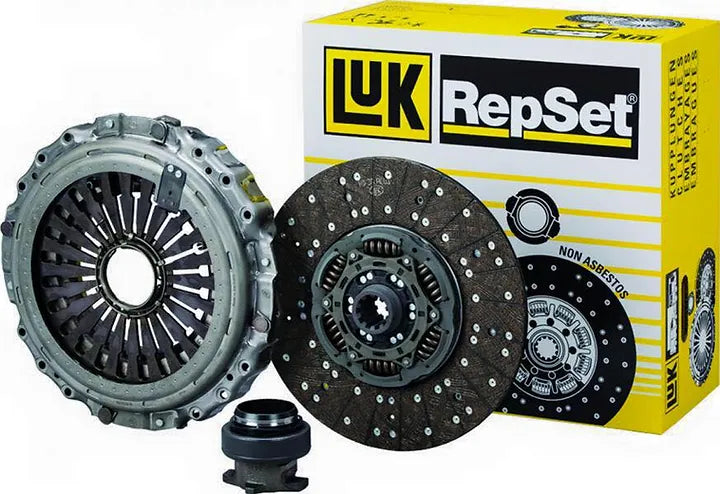If your vehicle is experiencing clutch & flywheel issues you may have some of the following symptoms listed in this guide. Without repairs, many of these symptoms will lead to a breakdown and the vehicle will require recovery to your local mechanic or clutch specialist.
For more information or further help please call Eco Torque on 01462 835335 or email info@eco-torque.co.uk.

Clutch & Flywheel Terminology
| Two Piece Clutch Kit | This kit includes the friction disc and pressure plate only. |
| Three Piece Clutch Kit | This kit includes both friction disc and pressure plate as well as release bearing or CSC. |
| CSC | Concentric Slave Cylinder |
| DMF | Dual Mass Flywheel |
Anatomy Of A Clutch & Flywheel System
A clutch system can comprise of different parts depending on the age of the vehicle and its setup. The three main components are the pressure plate, friction plate and release bearing or concentric slave cylinder (CSC).
Release Bearing with/without External Slave Cylinder or Concentric Slave Cylinder
Depending on the set up of the clutch system the vehicle may have one of a few different clutch operating components.
Earlier designs used a cable system which would be attached to the clutch pedal at one end and to an operating lever at the gearbox. This lever would then intern push a release bearing onto the diaphragm of the pressure plate, releasing the connection between the engine and gearbox.
Modern set ups use a hydraulic system removing the old cable design which would need adjusting as the clutch wore down. The self adjusting hydraulic systems use a master cylinder and a slave cylinder.
Slave cylinders operate the diaphragm on the pressure either directly (concentric slave cylinder) or via lever parts and release bearing (external slave cylinder).
Pressure Plate

|
 |
The pressure plate is a circular disc with a diaphragm which allows the disengagement of drive from the engine to the gearbox, allowing the selection of different gears. The pressure plate contains one of the two contact surfaces required for the friction plate to grip to in order to transfer power from engine to gearbox.
Friction Plate
The friction plate sits between the pressure plate and the flywheel. It is used to match the engine and gearbox speeds. Friction discs are like brake linings and a tiny amount of material is lost each time the friction plate makes contact between the two contact surfaces. This wear however, under normal use is minimal and the friction material should last 50'000 miles or more before requiring replacement.

|
 |
Flywheel
Manual clutch set ups normally have one of two flywheels installed. The flywheel serves two purposes in its design. It creates a mating surface for the clutch to be bolted too allow the disengagement of drive from the engine to gearbox. Its second purpose is in its mass, it uses the energy stored in its rotation to smooth out engine revs, stopping them from dropping drastically when the clutch is operated.
Solid flywheels are a single piece of metal formed into a round disc, which is bolted to the crankshaft of the engine. This was the only design up to the invention of the dual mass flywheel however this design is still the primary choice of commercial vehicles and high stress applications.
Dual mass flywheels (DMF) were designed to smooth the clutch engagement process by removing some of the torsional shock. The design incorporates a large and smaller disc which is spring loaded and set inside of the larger outer disc. These are common on diesel cars because of their high engine torque as well as most most vehicles with 1400cc engines or over.
The images below show a new dual mass flywheel with a cut out section. Image on the right is a solid flywheel.
Clutch Faults & Symptoms
Clutch Slip Symptoms
- Engine Revs Rise But No Forward Movement
- Burning Smell
- Gear Is Selected But No Movement

|
 |
What is clutch slip and what are the symptoms?
Clutch slip starts with minor symptoms and is usually first noticed on hard accelerations in upper gears. As time goes on, the effects grow larger and considerable slip is noticed in all gears, often leaving higher rev ranges being completely unusable.
If the issue is left uncorrected, it will ultimately lead to complete loss of drive with the vehicle and may also damage the flywheel due to the excessive heat created from the slipping on the surfaces.
If your cars' engine revs rise when you accelerate, but you do not gain any forward speed, this is a good indication of the clutch slipping. This issue is usually accompanied by a distinctive burning smell which may come through the air vents of the vehicle or outside of the car.
Clutch slip can also be caused by contamination of the friction plate. If the CSC fails by splitting it can allow hydraulic fluid to come into contact with with the friction plate, which will cause slippage and overheating. This can also be cause by oil seal failure by either gearbox or engine crank seal.

New clutch on left with distinctive friction grooves, with old worn out friction disc on the right.
Soft Clutch Pedal Symptoms
- Difficulty Selecting Gear
- Unable To Select Any Gears
- Clutch Pedal Feels Soft/Spongy
What is soft/spongy clutch and what causes it?
Modern cars use hydraulic systems to operate the clutch whilst driving. Compared to older cable versions, the new clutch operating systems often share the same fluid reservoir as the braking system.
The hydraulic fluid used is hygroscopic, which means its absorbs moisture. If water is present in the clutch fluid it will compress under pressure and cause the pedal to feel soft and spongy and unable to properly depress the clutch plate.
If the clutch hydraulic system has this issue the driver may be unable to select gear or get a crunching/grinding sound from the gearbox when they try to change gear.
This issue may not require the clutch to be changed and can sometimes be resolved by having the hydraulic system bled and replaced with new fluid.

Loss Of Clutch Pedal Symptoms
- Clutch Pedal On The Floor & Does No Return Up
- Unable To Select Any Gears
- Fluid Leak Under Car
What is clutch pedal loss and what causes it?
This issue and related symptoms are usually caused by a faulty Concentric Slave Cylinder (CSC).
If the seal fails on the concentric slave the fluid is lost out of the unit and will enter the clutch housing and will eventually leak on the floor. As the hydraulic pressure can not be sustained between the master cylinder and salve cylinder, the pedal will not return to the top once operated.
The CSC may also break and come apart without losing it's fluid resulting in a almost normal pedal feel but not drive in any gears. Below are images showing the the resulting damage from this type of failure.

Release Bearing /CSC Noise Symptoms
Screeching Noise When Clutch Is Depressed
Loss Of Drive
What is CSC noise and what causes it?
If your vehicle develops a screeching sound when the clutch pedal is depressed, it may be a worn concentric slave cylinder or release bearing. If this bearing has failed or is failing, it may create this sound when it comes into contact with the rotating pressure plate. If this fault is not rectified the bearing may overheat and collapse causing damage and may require repairs to the gearbox as well.

Flywheel Knocking Symptoms
- Knocking Sound On Start Up
- Knocking Noise When Clutch Is Depressed
- Vibration When Accelerating
What is DMF noise and what causes it?
When dual mass flywheels become worn they can cause vibration and knocking sounds that resinate throughout the vehicle. This often begins with a slight noise on start up and then develops to noises appearing during driving.

If you believe your vehicle is suffering from any of the symptoms listed or you require further information please contact us directly on
Eco Torque Ltd, Unit 1A Portland Ind Est, Hitchin Road, Arlesey SG15 6SG
01462835335




